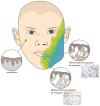New Frontiers in Our Understanding of Lymphatic Malformations of the Head and Neck: Natural History and Basic Research
- PMID: 29217059
- PMCID: PMC5726598
- DOI: 10.1016/j.otc.2017.09.002
New Frontiers in Our Understanding of Lymphatic Malformations of the Head and Neck: Natural History and Basic Research
Abstract
The future of head and neck lymphatic malformation (HNLM) evaluation and treatment is changing because of 2 decades of clinical research and recent basic science investigation. Basic science investigation using cellular biology and molecular genetics has revealed the genetic cause of some HNLMs, which has created the possibility of medical treatment specific to HNLM. This article summarizes the clinical and basic science research that will likely influence the future of HNLM assessment and treatment.
Keywords: Basic research; Head and neck; Lymphatic malformations; Natural history.
Copyright © 2017 Elsevier Inc. All rights reserved.
Figures








References
-
- Luks VL, Kamitaki N, Vivero MP, et al. Lymphatic and other vascular malformative/overgrowth disorders are caused by somatic mutations in PIK3CA. [Accessed 20150330];J Pediatr. 2015 166(4):1048–54. e1–5. http://dx.doi.org/10.1016/j.jpeds.2014.12.069. - DOI - PMC - PubMed
-
- Osborn AJ, Dickie P, Neilson DE, et al. Activating PIK3CA alleles and lymphangiogenic phenotype of lymphatic endothelial cells isolated from lymphatic malformations. Hum Mol Genet. 2015;24(4):926–938. - PubMed
-
- Longstreet B, Bhama PK, Inglis AF, Jr, Saltzman B, Perkins JA. Improved airway visualization during direct laryngoscopy using self-retaining laryngeal retractors: A quantitative study. Otolaryngol Head Neck Surg. 2011;145(2):270–275. - PubMed
-
- Dighe MK, Peterson SE, Dubinsky TJ, Perkins J, Cheng E. EXIT procedure: Technique and indications with prenatal imaging parameters for assessment of airway patency. Radiographics. 2011;31(2):511–526. - PubMed
-
- Perkins JA, Maniglia C, Magit A, Sidhu M, Manning SC, Chen EY. Clinical and radiographic findings in children with spontaneous lymphatic malformation regression. Otolaryngol Head Neck Surg. 2008;138(6):772–777. - PubMed
Publication types
MeSH terms
Supplementary concepts
Grants and funding
LinkOut - more resources
Full Text Sources
Other Literature Sources
Medical

